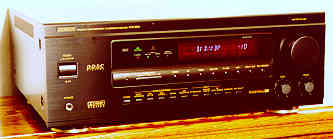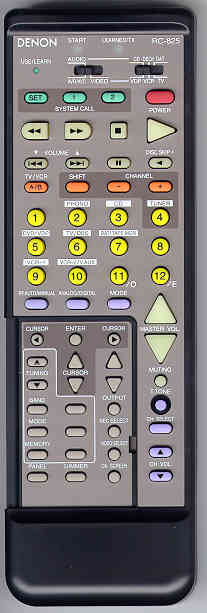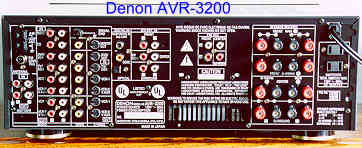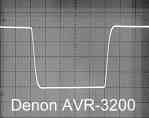Product Review - Denon AVR-3200 Receiver
with Dolby Digital Processing - January, 1998
Karl Suager
![]()
 |
Denon
AVR-3200 DD Receiver 80 Watts/Channel in all Five Channels Pro Logic and Dolby Digital Decoding w/RF demodulation Digital Inputs for DVD DD Signals Size: 6 1/2" H x 17" W x 13 1/2" D Weight: 31 pounds Price: $999 USA
|
| Denon Electronics, 222 New Road, Parsippany, New Jersey 07054; Web http://www.denon.com |
A receiver, eh? I've shopped and auditioned receivers with friends and family more than a few times, getting to know some models quite well, but the first and last time I let a surround sound receiver in my humble abode, my calendar would have read 1992. The model came with a noisy Pro Logic circuit, a phony matrix mode, a useless Hall DSP, 120 grainy watts per stereo channel, and 30 IC (Integrated Circuit; in other words, an amplifier on a chip!) watts to the center and rear each. Lots of glaring LEDs, a threatening hiss, and a real temper. It occasionally went into a rage and screamed at 1 kHz for no other reason than a private vendetta. Obviously, not the ES (Extra Special?) line. That $450 (MSRP $599 :>) fiasco deterred me from the all-in-one box convenience of receivers. I opted instead for the promised flexibility and performance of separate components, and, I'm glad to say, many of those components to follow have delivered on the promise
That's not to imply that receivers as a genre face a brick wall of performance limitations, but rather that the constraints of a convenient package, combined with the market demand for a reasonable price, put them at a severe disadvantage. By incorporating a tuner, designers must take more steps to isolate circuits from RF interference to equal the performance of a good integrated amplifier . . . a difficult task when an external antenna runs directly inside the chassis. Even then, the incorporation of power amplifiers inside the same chassis as the processor requires very careful layout, perhaps even extra shielding, and ideally separate power supplies. When you get into it, it becomes more cost effective to use an external chassis to provide distance and shielding, and completely separate transformers and filter capacitors. Voila, separate components! Not everybody loves more boxes, but in certain cases, they make sense
However, a receiver does not go without particular advantages. Besides offering an easy solution to radio reception, switching, signal tailoring, processing, and power amplification, receivers do make simple performance sense under certain conditions. If the individual isn't so picky about dynamics, doesn't demand what some might consider ridiculous amounts of clarity, isn't after the most flexible path to future upgrades, and if he/she has relatively efficient speakers with easy impedance loads, then separate components might be overkill. If one operates on a modest budget, a receiver may well provide better performance than similarly priced separates. After all, the extra chassis, power supplies, and connectors cost money. Personally speaking, for surround sound applications, I've found that the superior cost-to-performance ratio changes hands between receivers and components somewhere between $1,600 and $2,500 for equipment with the same general functions (in other words, above that range of money spent, one gets better performance with separates), while the division for standard stereo turns over at about $1,000 ($600 if you include an integrated amplifier as a separate component.) As price goes, the domains above and below belong almost exclusively to the different approaches. It then becomes not a question of what is best, but what is best for the individual buyer. After the paper, plastic, and boxes change possession, it's the end user who has the most important opinion.
In my opinion, for what it's worth, I think the Denon AVR-3200 is a reasonable package of performance and features at a reasonable price. And what does this little black box offer the user?

The remote proved easy to use, with a fairly standard layout and a small door for less used functions one might wish to forego in daily operation like the on-screen menu, dimmer, record out selector, and the manual tuning controls for the tuner, with presets buttons available elsewhere. It did provide direct access to level controls with a channel select button, right next to the muting and volume control, for tweaking movie soundtracks.
The front panel hosts, along with a big cylindrical knob to control the digital stepping volume control, basic treble, bass, & balance controls, different surround sound options, input selection, digital vs. analog input, record out selection, tuner operation, a headphone jack, and power. Pretty basic in itself. It has enough buttons to access all the listening modes, but not enough clutter to let miscellaneous family members or unwitting friends mess with the setup configuration. I thought the panel layout a nice balance between stark and crammed. It has enough direct access to avoid the use of a menu for the most part, but not so many to make finding the right button a chore.

The rear panel, like most receivers, provides real estate for connecting all that other equipment you've got hogging your cabinets. Plenty of audio and video inputs for everyone including toslink digital, coaxial digital, and RF input (the demodulator for RF modulated AC-3 signals.) S-video switching too, and all of that good stuff, although given the option, I'd hook video straight into the television, monitor, or projector, with one input to see the on-screen menu. The AVR-3200 does require the use of the on-screen menu to access some of the setup features. The most impressive feature I found on the back of this receiver was a set of 5.1 channel inputs! You can have your onboard AC-3 and DTS too, using an outboard DTS processor. The only thing it really missed was a pair of pre-out jacks for the rear channels. Too bad.
The 5.1 channel inputs were a definite plus on the plus/minus checklist. This, in my mind, is a key advantage over many other receivers in this price range also internally equipped with DD. You can add another processor (DTS) without commiting to an external amplifier in order to use it. In that sense, this receiver is easily upgradeable. However, it has no rear pre-amp outputs. Yes, you can add a three channel power amplifier for the front left/center/right, but none for the rear channels. I understand some of the logic in this. The rear channels will benefit from the power supply lifted of LCR duty with the addition of an external amplifier for the front channels, but it still seems very much an Achilles heel. If you will pardon the analogy, you can't upgrade your behind!
As mentioned, the built-in Dolby Digital comes with an on-board RF demodulator. I thought this kind of nice. That's one less box to buy if you're still using those archaic laserdiscs (I've still got one.) Besides turning what might be four boxes (demodulator, outboard AC-3 decoder, preamp, and amplifier) into one, given a choice between this receiver using Dolby Digital, and similarly priced separate components with Pro Logic, the receiver wins hands down. Not to say that the Dolby Digital in a mass market receiver surpasses the Matrix mode of the Theta Casablanca, but for this amount of money, you can't beat a good receiver with discrete digital surround. Once you get spoiled with the latest technology, intelligently applied in mixing, it's really very difficult to go back to the old "take 2 channels and separate them into 4." The Pro Logic section in the receiver was fair, but DD (AC-3) brings home the beans.
To take full advantage of AC-3, the AVR-3200 also provides individual level controls, including individual left/right rear levels not only for AC-3 operation (all AC-3 components offer that feature), but for Pro Logic too. This, coupled with digital time-alignment, was a big plus for me, as the setup of my rear channels is not perfectly symmetrical due to room considerations. The time delay for the center chanel, even in Pro Logic, provided a better spread across the front speakers. Otherwise the sound clumps to the center speaker, as the closer proximity in my arrangement, and the resulting psychoacoustical "precedence effect," steers perceived localizatoin towards the direction of the first arrival.
So far as the drive capability of the amplifiers goes, the transformer is relatively hefty for a receiver, and provides enough current to satisfy the demands set forth by the voltage output into moderate 8 ohm impedances, but the amplifiers are not recommended for use with nominal 4 ohm impedances. The manual quotes some impressive �dynamic� power into 4 ohm loads, but that means diddly, the accepted technical term being "squat". The audio quality itself, without any processing is not spectacular, but neither is it irritating. As a whole, the sound characteristics lean towards smooth, sacrificing a small amount of clarity instead of turning gritty or harsh. Certainly not a match for the Aragon 8008BB or the CinePro we had for audition, but with enough merit of its own to make quite a few listeners happy and content. With the NEAR speaker setup, although it didn't open up the full potential of the speakers, it played as loud as I desired using cinematic material without obvious distortion, and never drew my attention away from the video content. I'm guessing that with more efficient and amplifier-friendly speakers, the audio quality would improve a bit. I dare say, for what it is, the sound is OK. Maybe even pretty good in the context of its price and the host of other features.
But, then again, if you wanted awesome, as well as complete upgradeability with less of a budget constraint, you'd get into something like a B&K, Meridian, Lexicon, or so forth. Other DD receivers in this price range usually have the pre-outs for all channels, but no set of 5.1 inputs. The back panel on the AVR-3200 had plenty of space, so I guess perhaps Denon decided that the cost of the extra pre-outs would have pushed the retail just a bit too high. Whatever the reason, the outputs aren't there, which is the only complaint I can seriously justify in the context of the price of the unit, the inclusion of 5.1 inputs, onboard AC-3, and the included RF demodulator.
This receiver, for the most part, is a set and forget, relatively easy to use, somewhat upgradeable movie and music machine. The AVR-3200 packs a lot of features into that black box. Were it designed for me, I'd forego a few of those features in favor of more meat in the power supply, and circuits capable of greater open loop bandwidth (without negative feedback). Don't get me wrong. Feedback is OK if applied correctly, but when abused for the sake of specs to the extent that output inductors are required for high frequency stability, the sound quality suffers, sometimes marginally, sometimes not so marginally. Shown below is a 10 kHz square wave response. The corners are slightly rounded, due to output inductors limiting the bandwidth. Without the output inductors, the square wave corners might look more jagged, due to ultrasonic response peaks and less than adequate phase performance.
. 
Extra features can be interesting, but most enhancement software just isn't my thing. The AVR-3200 includes room size adjustment, to compensate for the size of listening area, and which I found only slightly helpful, if at all. The Cinema EQ, similar to THX re-equalization, tended to muffle the vocal range. The personal memory presets would be convenient if a person chose to take advantage of the different combinations of enhancements, and I can see genuine use of the one-button access for those family members who don't want to bother with selecting the input, pressing the analog/digital selector, and adjusting the volume, but I'm just not quite that lazy, yet. It also has a separate record-out selector which allows recording of one source (something on TV) by a second (VCR) while listening to a third (CD player). I've never needed that, and most likely never will. The extra DSP modes like "Jazz Club" or the 5 channel stereo mode, a directional enhancement DSP similar to Pro Logic, may prove fun at times, but I'd give them all up in half of a humming bird's heartbeat for four times as much storage capacitance and a bigger transformer.
Keep in mind that I'm not really a gimmickophile. Aside from slight compensation ability, all I want is clarity that doesn't hurt. I prefer to optimize a system, and then keep tweaking to a minimum. But, as software varies, as do room acoustics, I don't mind just a little tweaking factor, which brings up a few features I would have appreciated, such as digital EQ for individual channels. Even with matched speakers, room characteristics may interfer with the tonal balance between channels, especially important when matching the center channel, often above a television, with the left and right channels, often close to side walls. An EQ can allieviate much of this problem, even if it doesn't eliminate it. I'm glad that the AVR-3200 did have access to individual channel levels on the remote control itself, not only through the setup menu. The setup menu is easy to follow, but sometimes a hassle for the person who likes to adjust in the middle of watching a movie.
My overall conclusion is that although the Denon AVR-3200 is not built for the ultimate home theater experience, it does pretty well. It's not everything that I would ask for in a receiver, but what I would ask for in a receiver, I suspect, would run in the $2,500 range, and I do enjoy having this piece around. If your requirements match up with the substantial strong points of this piece, it's a bonafide contender. The audio quality is quite acceptable as is the Pro Logic decoding. The individual level controls to the rear for all surround modes are a plus, it's got inputs for a possible DTS addition (finally, including the subwoofer or LFE), and the on-board DD, when properly calibrated for the software, makes it a very viable addition to any list of perspective performers. To say the least, it has a lot going for it.
I have no problem recommending an audition of this Denon model. It's surely worth a trip to your local dealer.
Karl Suager
Associated components used for review:
NEAR 10M, 15M, and JIB Loudspeakers
JVC XLZ-1050 CD Player
Aragon 80088BB amplifier
Cinepro Professional Six-channel amplifier
Passive attenuator (50kOhm Nobel pot)
Bybee/Curl power purifier prototypes
API Power Pack V AC line conditioner
![]()
� Copyright 1998 Secrets of Home Theater & High Fidelity
Return to Table of Contents for this Issue.

